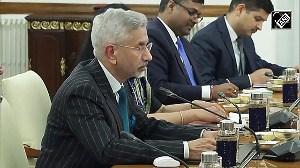It was the night between December 2 and 3 in 1984. It was a night when graveyards in Old Bhopal ran short of space and cloth merchants threw open their shops at midnight, freely donating any length of cloth to cover the endless corpses that were to be cremated or buried
It was a night when Bhopalis ran for their lives, chased by the fumes of 40 tonnes of methyl iscocyanate that was leaking from the pipes of the Union Carbide plant, thanks to a chemical accident.
People were fast asleep under quilts and woken up by shouts of those awake and screaming. They joined them to run for their lives, as their eyes burnt..as if potatoes boiled in hot water...This is how Bhopalis describe the hellish experience.
Those who survived got a compensation of Rs 1 lakh per dead. But, they are waiting for justice even now. They are still awaiting compensation for the futile years they have spent unable to do any work, with bodies wasted by ill health, lungs left too weak to breathe fully, pockets full of pills they have to pop now and then to keep going.
That wait was to have terminated on Monday in the verdict from the chief judicial magistrate's court. The verdict has finally nailed down eight accused executives of Union Carbide and also pronounced a sentence against them, as well as the company. The verdict of the chief judicial magistrate of Bhopal, however, looks too light in comparison to the lives lost by the people of Bhopal. The long wait for the verdict has also terminated in silence on the main accused -- the former chairman of the parent company, Warren Anderson, who was once proclaimed absconder by the same court.
Chasing Warren Anderson
The first step to pursue him was taken on December 1, 1987, when the Central Bureau of Investigation filed a chargesheet against him and, and 11 other accused, including UCC, Union Carbide (Eastern) Hong Kong, and UCIL. On July 6, 1988, the chief judicial magistrate, Bhopal, issued a letter to the US administration, seeking permission for the CBI to inspect the safety systems installed at the MIC unit of UCC's premier pesticide plant, the Institute in the State of West Virginia, USA. On February 9, 1989, CJM, Bhopal, issued a non-bailable warrant of arrest against Anderson, accused number one, for repeatedly ignoring summons.
On February 14, 1989, the US administration granted permission to CBI to inspect the safety systems of UCC's pesticide plant at Institute, West Virginia, for comparison of safety standards there and that installed at the Bhopal plant. While the matter relating to payment of interim compensation was being heard before the Supreme Court, UCC and the Government of India reached a settlement.
The settlement stipulated, inter alia, that UCC would pay $470 million as compensation and GoI would withdraw the criminal cases instituted against the accused in the Bhopal gas leak disaster case.
Following a review petition in October 1991 , the Supreme Court revoked the criminal immunity granted to UCC and all other accused in the Bhopal gas leak disaster case. To meet the medical needs of the gas victims, the Court further ordered GoI to construct a 500-bed hospital. The construction cost of the hospital and its running cost for eight years (which was estimated to be around Rs 50 crore at that time) was to be borne by UCC and UCIL.
In November that year, criminal cases against all the accused were revived in the CJM's Court in Bhopal. A proclamation was issued by CJM, Bhopal, ordering Warren Anderson (accused number one), UCC (USA) (accused number 10), and UCE (Hong Kong) (accused number 11), to present themselves before the CJM on February 1, 1992. A proclamation for Anderson's appearance was also published in the Washington Post. In 1992, the CJM declared Anderson, UCC (USA) and Union Carbide Eastern (Hong Kong) as absconders for non-appearance
in the criminal case. The CJM also declared that if the accused did not appear in court on March 27, 1992, their properties were liable to be attached.inline-block" id="div_arti_inline_advt">








